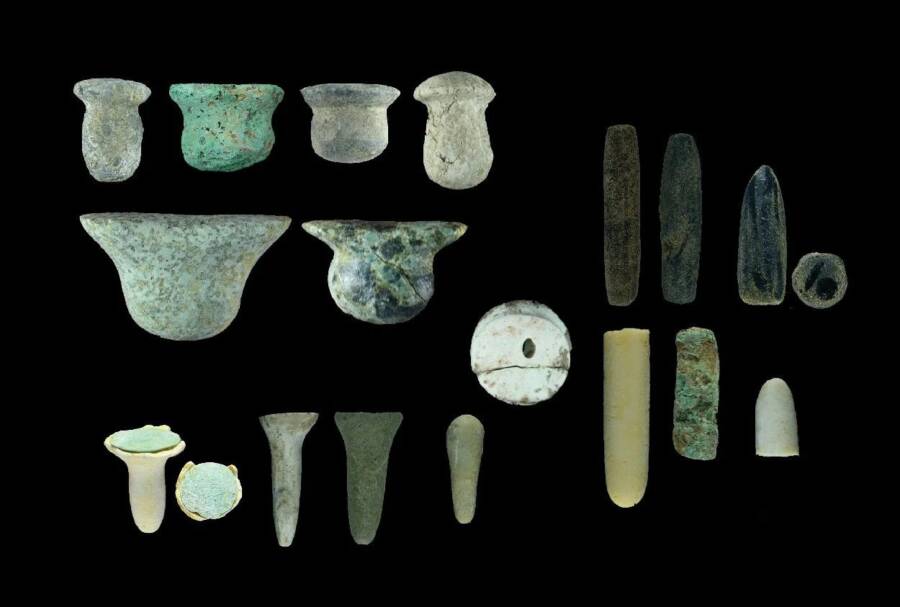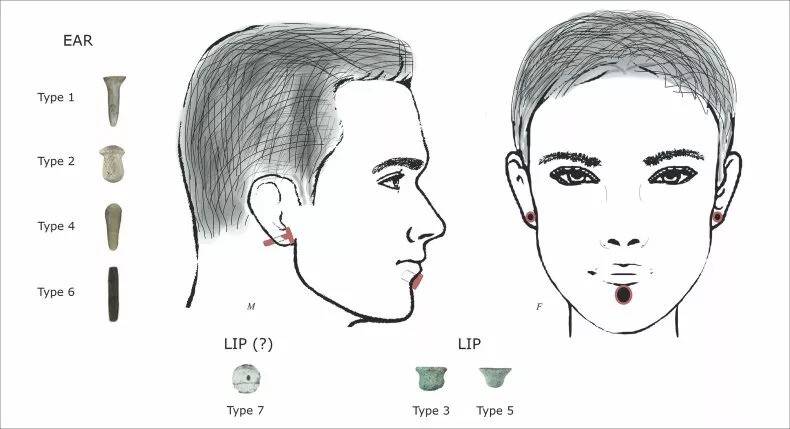The ornaments found at Boncuklu Tarla in Turkey were discovered alongside skeletons, marking the first time that such items were discovered "in situ" with human remains.

Emma Baysal/AntiquityArchaeologists found more than 100 objects like this one that were likely used as body piercings.
In our time, seeing someone with facial piercings might evoke a response about “kids today.” But the history of facial piercings is an ancient one. And archaeologists in Turkey just discovered the most compelling evidence yet of how ancient people used these body ornaments.
At the early Neolithic site of Boncuklu Tarla in Turkey, archaeologists discovered more than 100 ornaments alongside 11,000-year-old human remains. Though earring-like objects have been discovered before, these ornaments provide the “earliest contextual evidence” of facial piercings in southwest Asia.
The Body Ornaments Of Boncuklu Tarla
As reported in a new study in Antiquity, archaeologists discovered over 100 body ornaments at the Neolithic site of Boncuklu Tarla in Turkey. Significantly, the ornaments were discovered alongside the ears and chins of the 11,000-year-old human remains, hinting at their original position.
Though earrings have been found at Neolithic sites before, these ornaments are especially intriguing because they were found “in situ” within the human burials. What’s more, some of the skeletons had evidence of wear on their lower incisors, indicative of lower lip piercings known as labrets.

AntiquitySome of the body piercings found at the Boncuklu Tarla site.
“We have found the earliest examples of these ornaments still in place on the skeletons of the people who used them, thereby proving exactly how these ornaments were used at this early date for the first time,” Emma Baysal, one of the study’s co-authors and an archaeologist with Ankara University in Turkey, explained to Newsweek.
She continued: “We think these are the earliest examples yet recorded in their original context on the skeletons of the people who used them. We have earlier indirect evidence of labret use from other sites — but this is through wear on teeth and not directly from ornaments on skeletons.”
How Neolithic People Used Body Ornaments
The 100 ornaments, made of limestone, obsidian, flint, copper, and river pebbles, come in all different shapes and sizes. Archaeologists divided them into seven categories based on shape, which range from long-shafted ornaments probably worn in the ear (Type 1) to ornaments with shorter “bulbous” shafts (Type 3 and 5) which were used as labrets.
Intriguingly, the body ornaments were found among the remains of men and women at Boncuklu Tarla, but not among the remains of children. Children were sometimes buried with pendants or beads, but archaeologists did not discover evidence of ornaments near their heads like in other graves.

Emma Baysal/AntiquityThe different kinds of body piercings and how they might have been worn by Neolithic people.
This perhaps suggests that the body ornaments at Boncuklu Tarla served more than an aesthetic purpose. Rather than make a fashion statement, they may have signified some kind of Neolithic coming-of-age ritual.
“It’s probably something associated with being grown-up,” Baysal remarked to CNN. “Maybe a kind of social status associated with age, or a particular role in society.”
But though there’s still much to learn about how Neolithic people used body ornaments, what’s striking to archaeologists is how much facial piercings 11,000 years ago seem to resemble facial piercings now.
“Things we do today — i.e. use body piercings — can be traced back to some of our prehistoric ancestors many thousands of years ago at a time when they were just starting to settle down in the first villages,” Baysal noted to Newsweek.
To CNN she added: “When you put earrings on, you can’t see the earrings that you’re wearing. You’re not doing it for yourself, because you can’t see them. You’re doing it for how you project yourself to other people. And I don’t think that has changed for all these thousands of years. It’s a way that we can identify with people in the past and think, ‘Well, actually, they’re quite like us.'”
After reading about the 11,000-year-old body ornaments discovered in Turkey, go inside the long and fascinating history of piercings. Or, look through some of the most extreme female body modifications that exist around the world.





